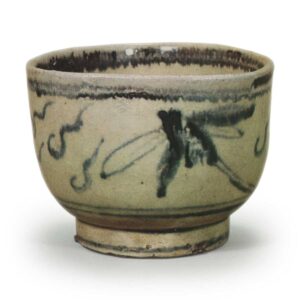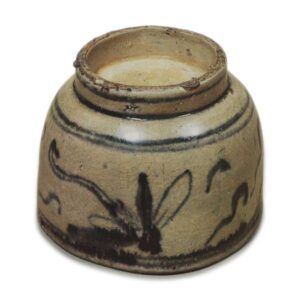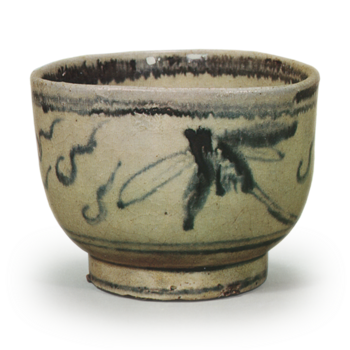

Nezu Museum
Height: 7.7cm
Diameter: 9.5cm
Height of foot ring: 6.3cm
Height of foot ring: 1.2cm
Annam is now Vietnam, but in ancient times it was strongly influenced by China, and in the northern region of the Qinghua area, pottery making developed early on. During the Tang Dynasty, celadon ware was already being produced in the Yuezhou kilns, and there were also examples of celadon and white porcelain produced in the Song kilns. The white porcelain of this period was made from fine white clay and had a soft glaze with a translucent, egg-colored crackle pattern, and the body and glaze were similar to the soft texture of Goryeo tea bowls. At the Nezu Museum, there is a Kaga-style An-nan white porcelain jar with a lotus petal relief around the rim and four handles, which is inscribed on the box as “Kumagawa water jar”, and which has been handed down in Kaga since ancient times. The clay, glaze and the way the stains are distributed all seem to suggest that the box inscription “Kumagawa” is appropriate. There are also pieces that imitate Ming-dynasty blue and white porcelain, and there are some early Ming-style pieces with excellent form.
However, most of the Annam ware that is prized as tea ceramics in Japan was produced in the early Edo period, during the reign of the Le dynasty, mainly at the Bat Trang kilns near Hanoi. This includes types such as underglaze blue and red, red overglaze enamels, and white porcelain, but the most popular of these is the underglaze blue and red ware, which is commonly referred to as “Annam Shibori-te” (Annam tie-dyeing) in Japan. This type of ware has a dark, yellowish glaze with a blackish glaze, but the glaze usually runs and oozes, hence the name “squeezed” ware. The name “squeezed” ware is also mentioned in the “Kaiki” (a book of memoirs) by Konoe Yorakuin in relation to Nanking-style ware, so it seems that this name has been used since ancient times. As this Annan-shibori ware is a type of miscellaneous pottery, it usually has a ring-shaped pattern of peeling glaze, known as a “snake’s eye”, and a thick glaze is applied to the inside of the foot ring. The free-flowing, unrestrained painting style is also likely to have been greatly appreciated by tea ceremony masters.
This type of ware is also known as “Annam dragonfly-patterned ware”, and the reason for this is that the dragonfly pattern is said to be a representative feature of Annam tie-dye ware, but the original of this pattern is none other than the bowl illustrated here.
The shape is almost triangular, with a large foot ring, showing the characteristics of Annan ware, and the underglaze blue is beautifully flowing, and the dragonfly design is full of tea-ceremony atmosphere, so it is truly worthy of the name of being a representative of the Annan ware.
There are also lines of underglaze blue on the inside of the rim and inside the bowl, and ash is applied to the bottom. The clay is a fine, light gray, and there are three marks on the foot ring. There is no snail pattern or mottled glaze on the inside of the bowl, but this is probably because it was ordered from Japan and was made to the customer’s taste, and this is the reason why this bowl, in particular, has a rich tea aesthetic.
This bowl was in the Fujita family, and when it was sold at auction in the past, it was sold for a very high price, and it was a surprise to the world that it ended up in the Nezu family.



